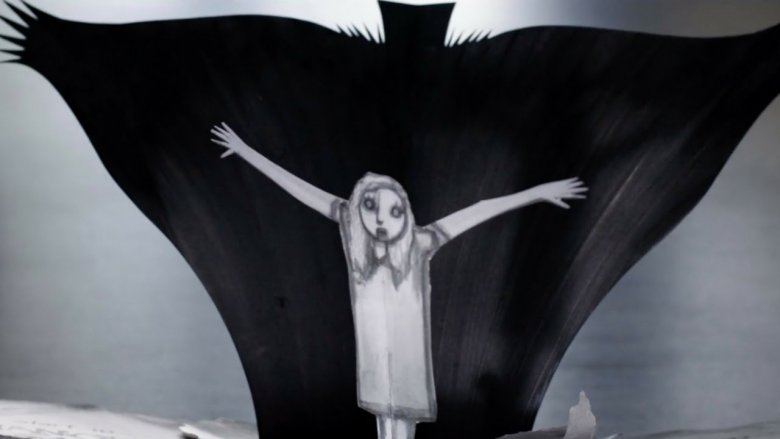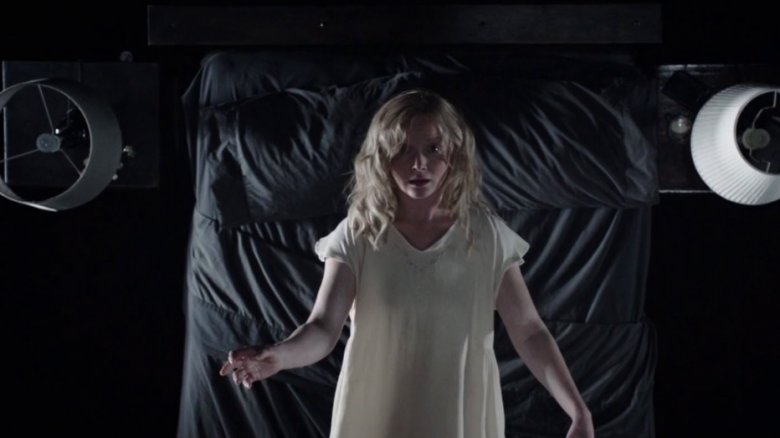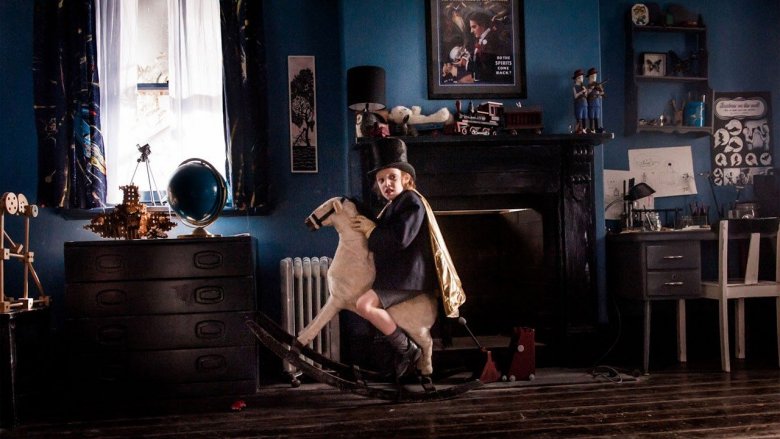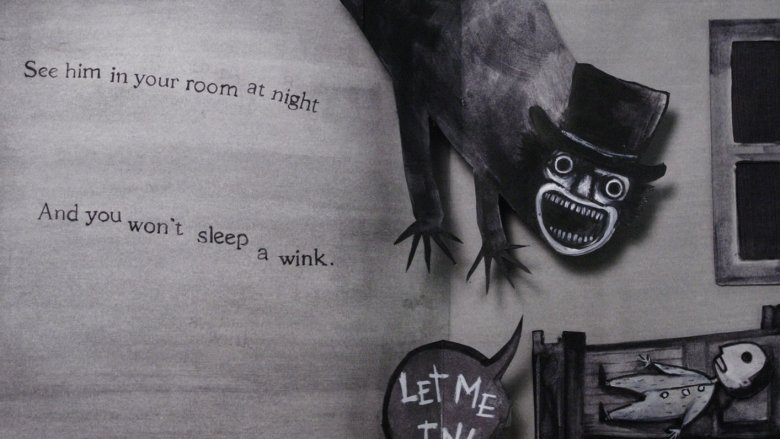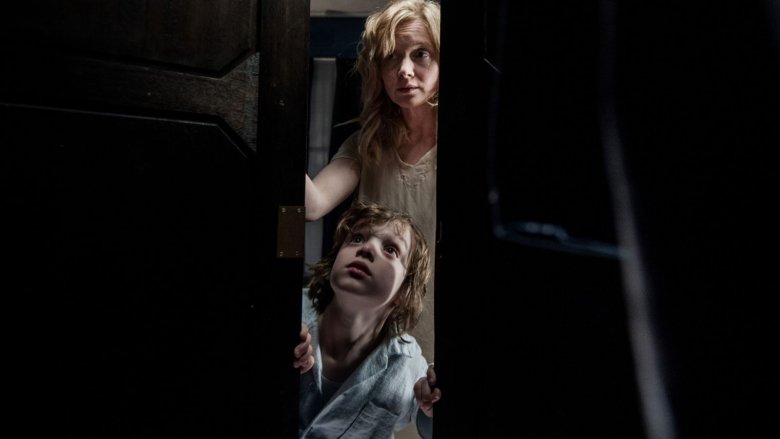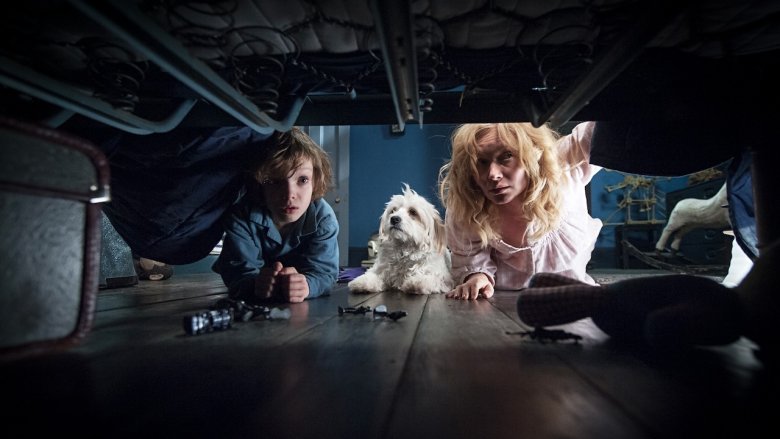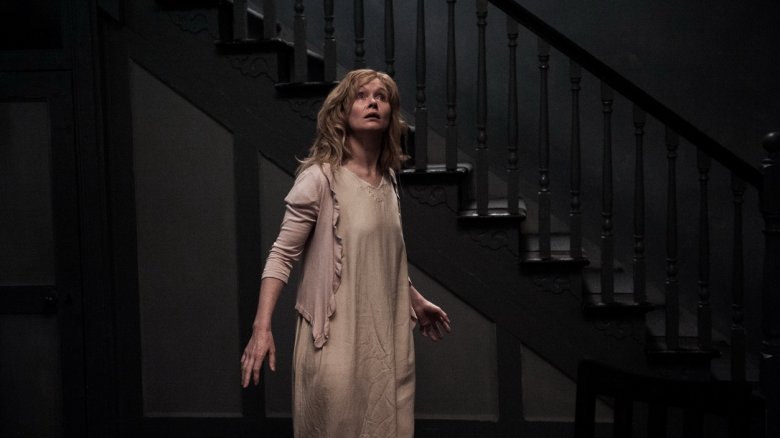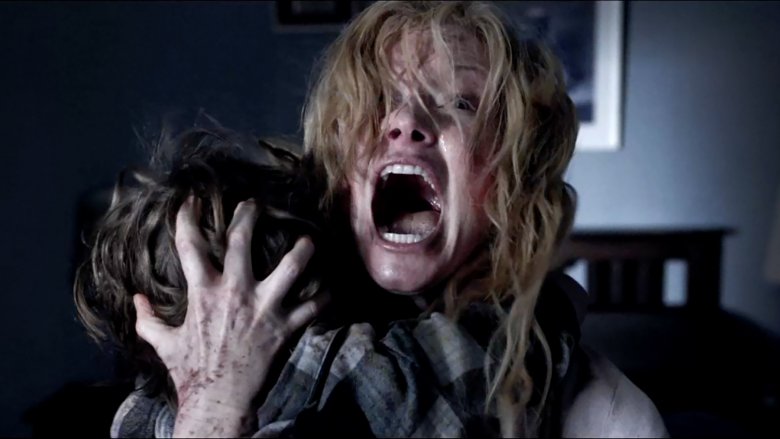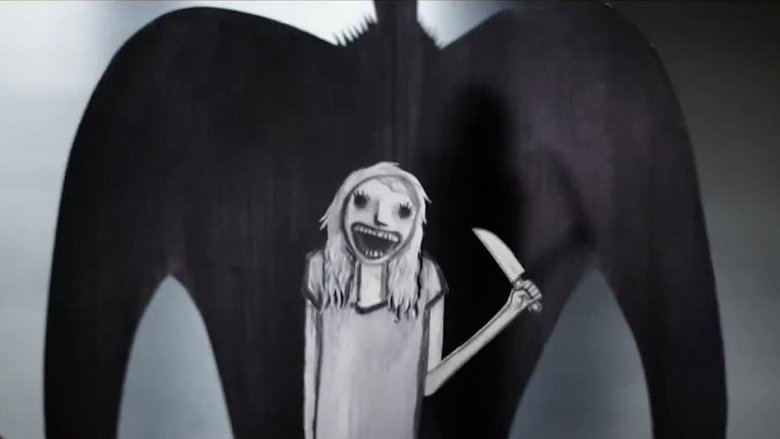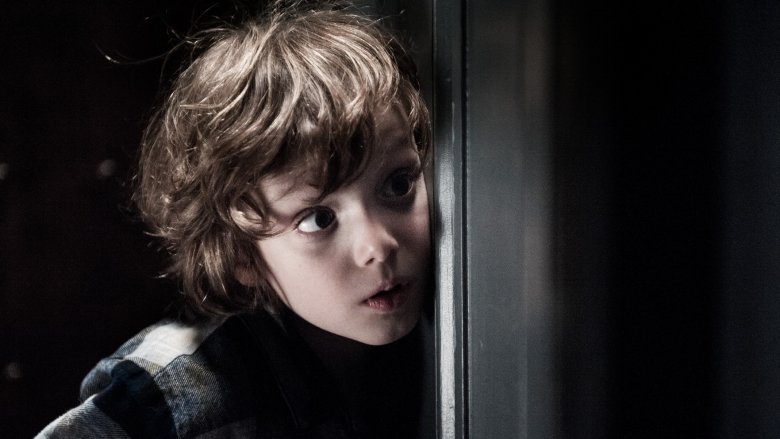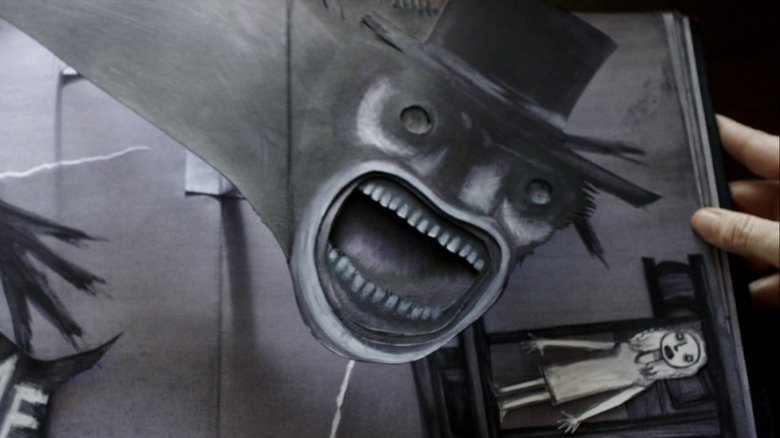The Ending Of The Babadook Explained
The 2010s have presented horror fans with a murderer's row of phenomenal films; Get Out, The Guest, The Witch, It Follows, Hereditary, and dozens more have seen the horror genre become more accessible to audiences than ever before. Part of the reason for this "new wave" of critically-acclaimed chillers comes from a renewed focus on contemporary fears that go beyond the shallow slashers and lazy jump-fests of yesteryear. Although the horror genre has always had a wider viewpoint and more diverse, interesting films than it's often credited with, the 2010s saw mainstream audiences finally tune in to films that might have gone otherwise ignored in favor of blunter, machete-wielding bloodbaths.
One film that absolutely contributed to the new horror renaissance is Australian director Jennifer Kent's The Babadook. The film's got plenty to say about grief and the exhaustion of motherhood while also being scary as hell. It's as frightening today as it was when it was first released in 2014, in part due to its moody, ambiguous ending. If it's in a look or in a book, you can't get rid of the Babadook... but you can understand it. Here is the ending of The Babadook explained.
Amelia is struggling
The Babadook opens on Amelia experiencing the traumatic event that underlines the entire film: her husband's death in a car accident en route to the hospital for the birth of their son, Samuel. It's easily read as a flashback or a horrible nightmare, but it's just as fair to say that the car accident that killed Oskar is the only event in her life that has mattered for the past six years. When she falls onto the bed in the opening scene, it's as if the past six years since that moment have only been a dream.
Samuel is six years old, and our first glimpse of him is him waking up Amelia. It's a metaphor for a theme that echoes throughout the entire film. Amelia is sleepwalking through her days and marking the hours until the dark times fade, but she's entirely stuck on Oskar's death — an event that's so intertwined with Samuel's birth that she struggles to be the mother that he needs her to be. And unfortunately for her, Samuel is not an easy child to raise.
Samuel is a handful
Motherhood is a ripe subject for horror films. There's the ever-present fear that every parent has of their child being in danger, but there's also the fear of your own identity getting shifted and transmuted after child birth. How does being a parent change your fundamental self? Still, it's rare for a film to reckon with the messy bits of parenthood, those moments that don't make easy fodder for a mommy blog or fun anecdotes — moments when you simply don't have the patience or energy to be the parent your child wants and needs you to be.
The Babadook rides a tight line between showing how exhausted Amelia is while also showing how much energy it takes to parent Samuel. He's eminently precocious in a way that few movie children are. Rather than helping her with bills and chores like child geniuses in terrible movies, Samuel screams and shouts. He builds traps like a more vindictive Kevin McAllister. He's quickly kicked out of school after he brings a weapon. As much as Amelia is struggling to overcome Oskar's death, Samuel drains her even further. In one telling scene, Amelia tries to have an intimate moment with herself (in one of the film's few depictions of sexual desire) before immediately getting interrupted by Samuel screaming.
If it's in a look or in a book
If dealing with crippling grief and an unruly child wasn't enough, the titular monster soon makes an appearance when Samuel finds Mister Babadook, a book that's appeared mysteriously on his bookshelf. Although Samuel is initially excited for Amelia to read the new book to him, that excitement quickly turns to fear once they begin. The book describes a horrible monster called the Babadook that invades its' victims thoughts and home and is impossible to banish. As the book reads, "If it's in a look or in a book, you can't get rid of the Babadook." Like a tick or unwanted ideation, the Babadook burrows in deep and it soon becomes a constant source of fear for both Samuel and, eventually, Amelia.
Samuel's behavior intensifies as he suffers from insomnia and persistent nightmares that the Babadook is inside the house. Amelia's own insomnia gets worse, and their fragile relationship is stretched to the breaking point.
You can't get rid of the Babadook
Strange events start to happen in the household after Amelia reads Samuel the book. She finds glass shards in her food and hears spooky sounds at night. Amelia destroys the book in the hopes that it's just caused Samuel to act out. His interest in magic and traps makes him an easy scapegoat, especially when he can't seem to go five minutes without screaming and making a fuss.
Soon, Samuel suffers a seizure after he and Amelia are seemingly attacked by an invisible creature on the roof of their car. Worse, Amelia finds a reconstructed Mister Babadook on the steps of their home that tells her that the Babadook will become stronger the more she tries to push it away. The book tells her, "I'll wager with you, I'll make you a bet. The more you deny, the stronger I get. You start to change when I get in, the Babadook growing right under your skin." The Babadook's aim is clear; it wants to take over Amelia. As empty and drained as she's been, she's easy prey for the Babadook to grow inside her.
Amelia doesn't know how to ask for help
The Babadook is a potent metaphor for all sorts of mental ailments, from postpartum depression to overwhelming grief. Part of the reason that the monster works so well as a metaphor is that Amelia doesn't have the strength to ask for help. In the literal sense, it seems like she's being attacked by a horrible monster that's invisible and seemingly omnipresent. In the metaphorical sense, she's struggling with violent urges towards her son. In either case, she can't possibly ask for help and sound remotely stable. She can't ask for help from the motherly neighbor next door, she can't ask for help from her surprisingly judgmental sister, and she can't ask for help from her co-worker who has an obvious crush on her.
She and Samuel become steadily more isolated from everyone as the Babadook grows more and more powerful. Whatever sleep Amelia was able to grasp before becomes nonexistent after it invades the house.
Themes and influences of the Babadook
In terms of visual design, the Babadook owes equal influence to German Expressionism and the work of Edward Gorey. The creature is all jagged corners and suffused with a slick, oily blackness that blends into the walls. German Expressionism was an artistic movement interested in exploring highly stylized stories that often dealt with themes of insanity and betrayal. As far as direct references go, Amelia's insomnia-fueled television marathons feature a number of films either of the German Expressionism movement or strongly influenced by it, like Phantom of the Opera and Carnival of Souls. The Mister Babadook book, meanwhile, is blatantly influenced by Gorey's thick linework and gently-misshapen figures.
These clear influences aren't just an artistic flourish; it gives both Amelia and the audience a form with which to categorize the Babadook. It's as much in Amelia's head as it is real. In classic German Expressionism form, the monster is both an actual, true monster and also an imaginary visualization of Amelia's exhaustion and mental illness.
Give me the boy
The visions Amelia is experiencing come to a head when she sees Oskar, seemingly returned to life. He tells Amelia that they can be together again, but first she has to do something. He tells her, "You just need to bring me the boy... You can bring me the boy." Samuel and Oskar's lives are permanently intertwined in Amelia's mind. Oskar died the night that Samuel was born, and the resulting trauma has made Amelia incapable of resolving that grief. The Babadook needs her to kill Samuel, and the only way to assure that she does so is by dangling the promise of Oskar's return.
The emptiness that Amelia's felt ever since Oskar's death has made her an easy vessel for the Babadook to fill with violence and vitriol. That is exactly what happens when, minutes later, the Babadook literally possesses Amelia, filling her with its poison. It promised her that the more she denied it, the stronger it would get, and it's finally become strong enough to fully control her.
Samuel wakes Amelia up
After Amelia is possessed by the Babadook, it's up to Samuel to try to save her. His earlier promises that he would protect her from the monster seem like a cruel joke, as she has become the monster — a monster fueled by grief and violence so far gone that she even kills their dog. Samuel uses his various traps to incapacitate Amelia, eventually managing to isolate her in the cellar. The cellar is where the remains of Oskar's things are, and we've seen Amelia emphatically avoid it throughout the movie. Just like in the opening scene, Samuel manages to wake Amelia up from her grief in a cathartic expulsion of the Babadook's influence inside the room that Amelia's spent six years avoiding as much as she can.
Even though the Babadook is expelled from Amelia, it's still in the house, and it still wants Samuel. But just as Samuel saved Amelia from the Babadook, Amelia saves Samuel. She shouts down the demon in a stand-off, forcing it to flee to the cellar in defeat.
There's something in the basement
With the Babadook banished to the cellar, Amelia seems more energetic and awake than we've ever seen her. She's caring and warm towards Samuel, and the harsh editing and sound mixing that characterized Samuel's temper tantrums earlier in the film is completely gone. It seems like a happy ending... until we see why Samuel was gathering earthworms from their garden.
Amelia takes the worms down to the Babadook, which is still living in the cellar. It nearly attacks Amelia, but she manages to calm it down; although she's shaken when she returns to Samuel in the backyard, it's a far cry from her earlier experiences with the monster. Just as the book repeated so insistently, you can't get rid of the Babadook... but it turns out that you can live with it. It's still in the basement, and it's still dangerous, but it's a thing that Amelia can live with now that she's stopped denying it.
So just what is the Babadook?
The end of the movie sees Amelia acknowledging the Babadook as a permanent presence in their lives. In keeping with its symbolic representation of grief and mental illness, there's no ultimate victory over it. Amelia still has to reckon with it every day, has to acknowledge the role it plays in her life going forward. But giving herself the room and time to feed her grief lets her be awake, really awake, for the first time that we've seen in the film. One of the most important lines of dialogue comes right before Amelia goes into the cellar to feed the Babadook: Samuel asks if he's "ever going to see it," and Amelia responds, "One day. When you're bigger."
If the Babadook represents the grief that Amelia feels over Oskar's death, then Samuel will have to eventually reckon with it too. He might not have ever known Oskar enough to mourn him the way he would if he'd known his father before his death, but that grief is waiting in the wings for when he's older. This also fits the idea that the Babadook represents mental illness — many forms are hereditary. It's likely that Samuel will one day have to battle the same monsters, figurative and literal, that Amelia's struggled against.
